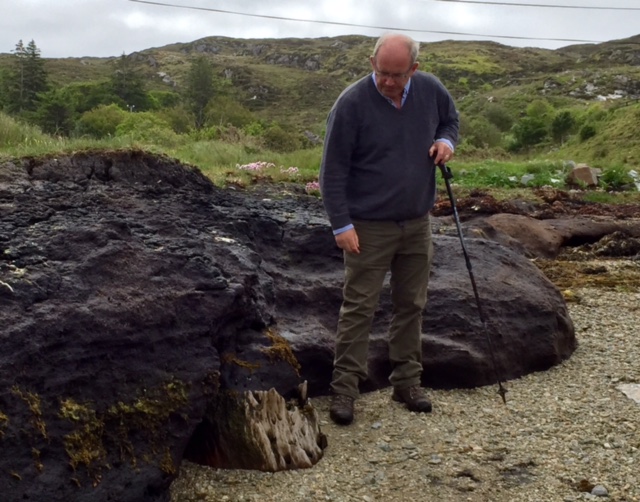The earth is changing. In fact, it is in a constant state of change. Tectonic plates slowly grind and move. Mountains lift in the Himalayas, and slowly wear down in the Appalachians. I’m now sitting in a cottage in Ireland looking out over the rocky landscape of the Burren north of Doolin in County Clare. It is a jumble of limestone set down in layers as this part of Ireland was once at the bottom of a shallow sea some 350 million years ago. More recently, great sheets of ice moved from the north, scraping away deposits of more recent sediments from this ancient bedrock. Shale, mudstone and sandstone were stripped away and moved south, leaving the limestone sticking from the earth like an ancient skeleton. The Burren is a testament to how our earth has changed in grand ways over millions of years. But it is hard for humans to relate to time on such a grand scale.
A couple of days ago, I had a wonderful opportunity to amble across the boggy countryside near the hamlet of Roundstone in County Galway. We were lead by archaeologist Dr. Michael Gibbons. We learned about the long, often heartbreaking history of the people who had to live in this hardscrabble landscape. All of western Ireland was once covered in rich forest. As human population grew, and dependency on wood grew, the trees were removed for timber and fuel. Once the trees were gone, humans took to burning peat for fuel. Even today, there are still areas of Ireland where houses are heated with peat.
These peat bogs took thousands of years to form and are built up of layers of organic plant material. Sphagnum moss and other bog plants form thick layers of rich organic matter. The high acidity and low oxygen levels never let them fully decay. Once they are cut from the bog and left to dry, they yield “bricks” of what the locals call “turf.” There is an effort to protect the few remaining peat bogs from destruction, but protecting these habitats often runs the challenge of long standing practices of harvesting peat for fuel. Turbary rights run deep in Ireland, and are generations old.
Our tour with Dr. Gibbons took us to the shoreline near Roundstone. The tide changes in this part of the world are quite drastic, with 6-meter changes in ocean level happening on a twice-daily basis. It was now low tide and we could walk out to areas that would be underwater in a few hours. As we walked out on the tidal flats, he reminded us to “keep your hands out of your pockets, and a hat on your heads.” The reason for the warning is that in this area, it’s entirely possible to break through the sandy tidal flat and find yourself deposited in an ancient peat bog. Your hands can catch you if that happens, and if that doesn’t work, your hat will at least mark your place so he would know where to look.
Fortunately, we didn’t have to look under stray hats on the sand for any of our group, but we did find an ancient bog. Thick, black layers of peat were in the tidal flats, and within these mats of peat were ancient tree stumps and logs. Spruce, fir, and other species stood looking as fresh as if they were cut yesterday, but these were thousands of years old, preserved in the quiet realm of suffocating peat for millennia. Then Dr. Gibbons does what any good guide will do, leave you with an “ah-ha moment.” That’s the point on a tour when the guide hits home with some tidbit of info that turns the world upside down. Why are these ancient bogs under the level of high tide today? Sphagnum bogs and fir trees cannot grow in salt water. Why are they there now?
The simple answer is that the ocean levels are higher today, but the reason behind that answer is not so simple. We are between ice ages. This ancient peat was laid down when much of the Earth’s water was locked up in vast glaciers. As those glaciers slowly melted, the ocean levels rose to flood the land. Today, we are seeing the continuation of this change in the climate. Climate change is a fact. It has been happening on this planet as long as we have had a thin layer of atmosphere surrounding our rocky mantle. Past civilizations have risen and fallen on subtle changes in long term climate and associated weather. The earth has always changed, but today we are seeing unprecedented changes in the world’s climate, and all indications are that the human species is one of the leading contributors to exacerbating the rate of change. A rudimentary study of history shows that the Earth is a harsh enough place to live without tinkering with the delicate balance of atmospheric conditions. What will an archeologist tell a group 10,000 years from now when it’s our turn to be the ancient past.


Recent Comments